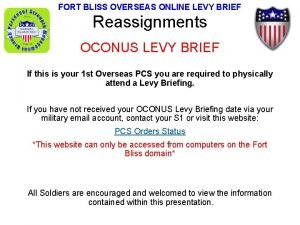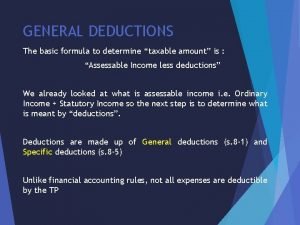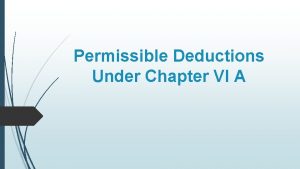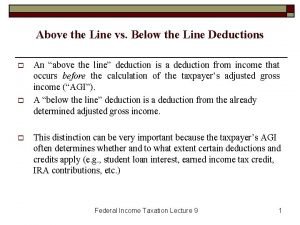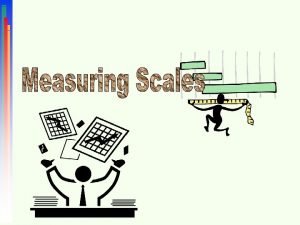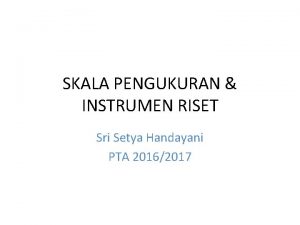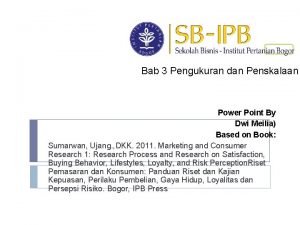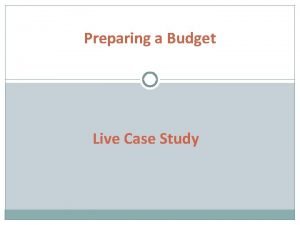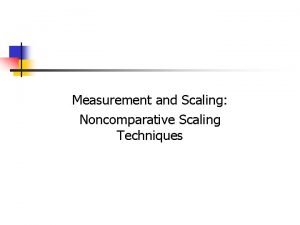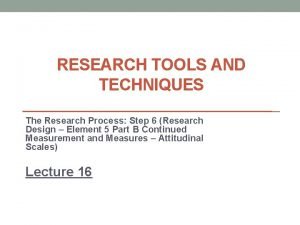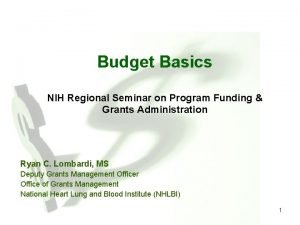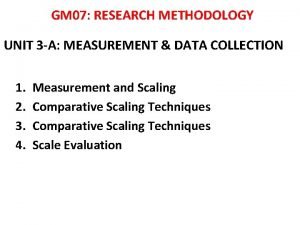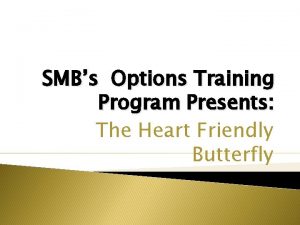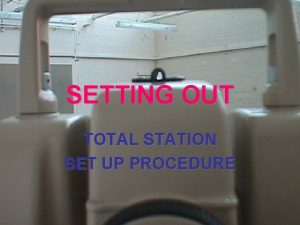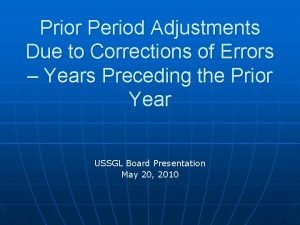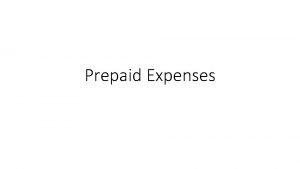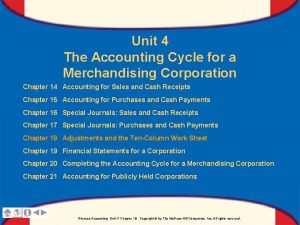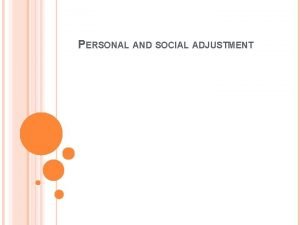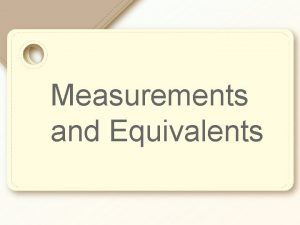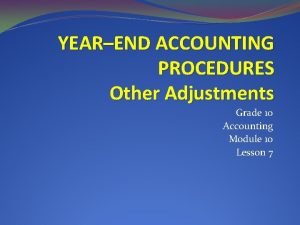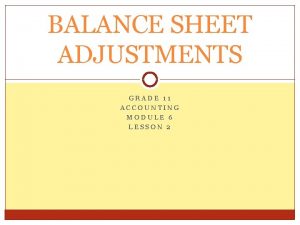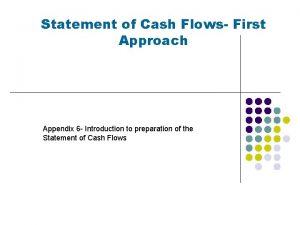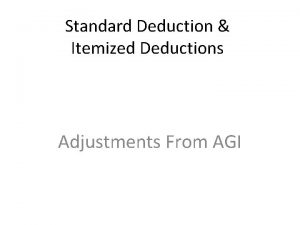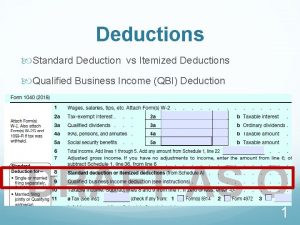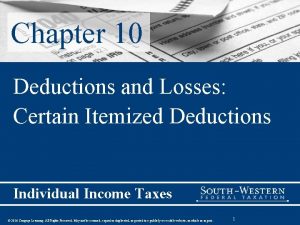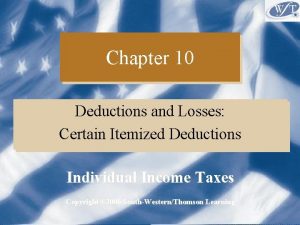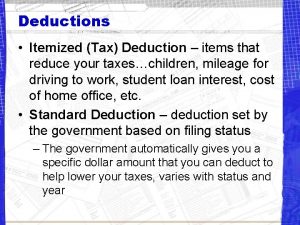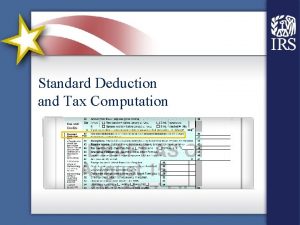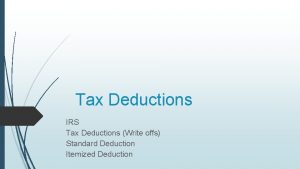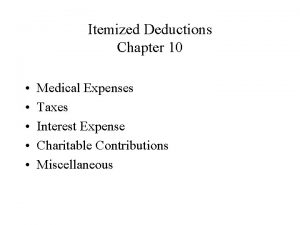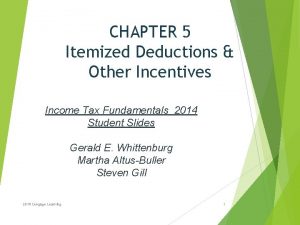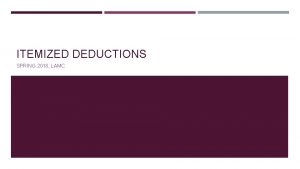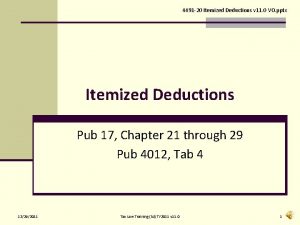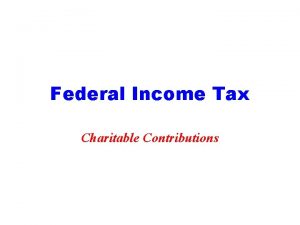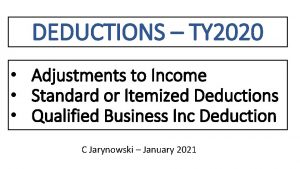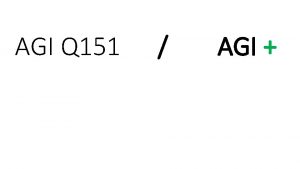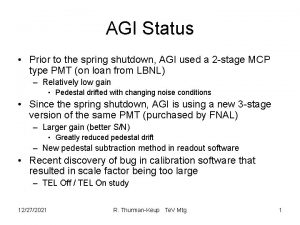Standard Deduction Itemized Deductions Adjustments From AGI Standard































- Slides: 31

Standard Deduction & Itemized Deductions Adjustments From AGI

Standard Deduction and Tax Computation

Deductions • Subtractions from a taxpayer’s adjusted gross income (AGI). They reduce the amount of income that is taxed. • Taxpayers have a choice of taking a standard deduction or itemizing their deductions. When taxpayers have a choice, they should use the type of deduction that results in the lower tax.

Standard Deduction • Predefined dollar amount that is based on the taxpayers’ filing status. • Additional rules apply if the taxpayer or spouse is age 65+, blind or both.

Standard Deduction • People who can’t take the standard deduction: –Taxpayer is filing MFS and the spouse is itemizing deductions –Nonresident or dual-status alien during the year (and not married to US Citizen or residents by the end of the year)

Out of Scope Situations for VITA/TCE • The following is out of scope for this lesson. While this list may not be all inclusive, it is provided for your awareness only. – Casualty and theft losses

Itemized Deductions • Allow taxpayers to reduce their taxable income based on specific personal expenses. • Taxpayers benefit from itemizing deductions if they have mortgage interest, very large unreimbursed medical or dental expenses when compared to their income, certain taxes, casualty and theft losses or other large expenses such as charitable contributions. • Expenses are entered on Schedule A

Itemized Deductions-Medical and Dental Expenses • Medical and Dental Expenses – Can deduct only the amount of unreimbursed expenses that exceeds 7. 5% of their AGI • Qualified medical and dental expenses paid by the taxpayer during the tax year can be included for: – The taxpayer's spouse – Dependents (must have qualified as dependents at the time the medical services were provided or at the time the expenses were paid)

Guidelines to Follow • If the taxpayer itemize the spouse has to itemize or claim “ 0” • Be sure the expenses were not paid with pretax dollars or reimbursed by an insurance company. • Retired public safety officers cannot include as medical expenses any health or long-term care premiums they elected to have paid with tax-free distributions from their retirement plan. • If a child of divorced or separated parents is claimed as a dependent on either parent's return, each parent may deduct the medical expenses they individually paid for the child.

Medical Expenses

Where to Look/Tips • Deductible medical and dental expenses are reported and calculated on lines 1 through 4 of Schedule A. • Review Whose Medical Expenses Can You Include? in the Medical and Dental Expenses chapter of Publication 17. • Also, refer to the Interview Tips - Itemized Deductions in the Volunteer Resource Guide (Tab F). • If a child of divorced or separated parents is claimed as a dependent on either parent's return, each parent may deduct the medical expenses they individually paid for the child. • If you and a taxpayer disagree as to whether a particular expense is deductible, politely refer the taxpayer to the Site Coordinator. The taxpayer may be correct, but you should not deduct an expense unless you are sure it is deductible.

Itemized Deductions-Deductible Taxes • Deductible Taxes – State and local taxes (choose 1 not both) • Income taxes: withheld taxes or estimated tax payments • Sales taxes – Real estate taxes • State, local, or foreign real estate taxes that are based on the assessed value of the taxpayer's real property, such as the taxpayer's house or land • Mortgage Interest Statement Form 1098 • Some real estate taxes are not deductible, including taxes for local benefits and improvements that tend to increase the value of the property, itemized charges for services, transfer taxes, rent increases due to higher real estate taxes, and homeowners association fees. – Personal property taxes – Other taxes

Personal Property Tax • Personal property taxes are deductible if they are: – Charged on personal property – Based only on the value of the personal property, and – Charged on a yearly basis, even if collected more or less than once a year

Other Taxes • Other Taxes — list the type and amount of any other qualified deductible taxes in the Other Taxes section of Schedule A, such as qualified foreign income taxes

Where to Look/ Tips • For more details, refer to Which Taxes Can You Deduct? in the Taxes chapter of Publication 17. • Also, refer to the Interview Tips - Itemized Deductions in the Volunteer Resource Guide (Tab F). • State and local tax withheld is sometimes shown on Form W-2 in either box 17 or 19. • Real estate taxes are reported on Form 1040, Schedule A. • Other taxes, including personal property taxes, are reported on Schedule A, line 8. • Generally, income taxes paid to a foreign country can be taken as: – An itemized deduction on line 8 of Schedule A and entered on Form 1040, line 40, or – A credit against U. S. income tax on Form 1040, line 47

Itemized Deductions • Mortgage Interest • Any interest paid on a loan secured by the taxpayer’s home, line of credit, or a home equity loan

Guidelines to Follow • Certain types of interest are deductible as itemized deductions. Home mortgage interest, points (paid as a form of interest), and investment interest can be deducted on Schedule A. • Interest that cannot be deducted includes: – Interest on car loans where the car is used for nonbusiness purposes – Other personal loans – Credit card investigation fees – Loan fees for services needed to get a loan – Interest on a debt the taxpayer is not legally obligated to pay – Finance charges for nonbusiness credit card purchases • Remember that taxpayers may have more than one mortgage or may have refinanced during the year and may have multiple Mortgage Interest Statements. Be sure to include them all.

Where to Look/Tips • Use the flow chart — Is My Home Mortgage Interest Fully Deductible? — in Publication 17 to determine if the interest should be included on Schedule A. • A taxpayer may be able to deduct interest on a main home and a second home. A home can be a house, cooperative apartment, condominium, mobile home, house trailer, or houseboat that has sleeping, cooking and toilet facilities. • Taxpayers receive Form 1098, Mortgage Interest Statement, which shows the deductible amount of home mortgage interest paid by the taxpayers • Points Flow Chart-Use the flow chart - Are My Points Fully Deductible This Year? - in the Interest Expense chapter of Publication 17 to help you determine if the points are fully deductible.

Itemized Deductions-Contributions to Charity • Charitable Contributions is a donation or gift to a qualified organization. Taxpayers must itemize deductions to be able to deduct a charitable contribution. Taxpayers can deduct contributions to qualifying organizations that: – Operate exclusively for religious, charitable, educational, scientific, or literary purposes, or – Work to prevent cruelty to children or animals, or – Foster national or international amateur sports competition if they do not provide athletic facilities or equipment • Other qualifying organizations include: – War veterans' organizations – Certain nonprofit cemetery companies or corporations – The United States, or any state, the District of Columbia, a U. S. possession (including Puerto Rico), a political subdivision of a state or U. S. possession, or an Indian tribal government or any of its subdivisions that perform substantial government functions • Keep record of all qualifying contributions

Itemized Deductions-Charitable Contributions • Deductible items include: – Monetary donations – Dues, fees, and assessments paid to qualified organizations above the value of benefits received – Fair market value of used clothing and furniture in good condition – Cost and upkeep of uniforms that have no general use but must be worn while performing donated services to a charitable organization – Unreimbursed transportation expenses that relate directly to the services the taxpayer provided for the organization – Part of a contribution above the fair market value for items received such as merchandise and tickets to charity balls or sporting events – Transportation expenses, including bus fare, parking fees, tolls, and either the cost of gas and oil or a standard mileage deduction of 14 cents per mile

Guidelines to Follow • Taxpayers must keep records to prove the amounts of cash and noncash contributions they make during the year. Report cash, check, and noncash contributions on Schedule A, line 16 and 17 respectively. • For each contribution, tell taxpayers they cannot deduct a cash contribution, regardless of the amount, unless one of the following records of the contribution is kept: • A bank record, such as a canceled check, a copy of the canceled check, or a bank statement containing the name of the charity, the date, and the amount • A written communication from the charity, which includes the name of the charity, date of the contribution, and amount of the contribution • For unreimbursed expenses related to donated services, the taxpayer must have: • Adequate records of the expenses • Written acknowledgment from the organization and a description of the taxpayer's services

Limits on Contributions • Taxpayers whose total contributions are more than 20 percent of their AGI may only be able to deduct a percentage of their contributions and then carry over the remainder to another tax year. The percentage varies, depending on the type of gift and the type of charitable organization. • Noncash Contributions Less Than $250 – For any single contribution of less than $250, tell the taxpayer to keep: – Receipt or other written communication from the organization or the taxpayer's own reliable written records for any item, showing: • Name and address of organization • Date and location of the contribution • Reasonably detailed description of the donated property • Fair market value of the donated property • Noncash Contribution Deductions of More Than $500 • Taxpayers with more than $500 in total noncash contributions must file Form 8283 and should be referred to a professional tax preparer.

Itemized Deductions: Non-Qualifying Contributions • Organizations that do not qualify for deductible contributions include: – Business organizations, such as the Chamber of Commerce – Civic leagues and associations – Political organizations and candidates – Social clubs – Foreign organizations – Homeowners' associations – Communist organizations

Itemized Deductions: Non-Qualified Cont’d • Amounts that may not be deducted include: Cost of raffle, bingo, or lottery tickets Tuition Value of a person's time or service Blood donated to a blood bank or Red Cross Car depreciation, insurance, general repairs, or maintenance – Direct contributions to an individual – Sickness or burial expenses for members of a fraternal society – Part of a contribution that benefits the taxpayer, such as the fair market value of a meal eaten at a charity dinner – – –

Where to Look/ Tips • To be deductible, contributions must be made to a qualifying organization, not an individual. • Publication 78, Cumulative List of Organizations, is a list of organizations eligible to receive tax-deductible charitable contributions. An online version is offered to help taxpayers conduct a more efficient search of these organizations. • To find out if the organization is a qualified charity, call the IRS at 1 -877 -829 -5500 or refer to the IRS web site at www. irs. gov/app/pub-78/. • More information on charity limitations is available in Publication 17. Refer taxpayers affected by limits on charitable deductions to a professional tax preparer. • Charitable contributions-See Publication 17, Contributions, for the rules applicable to out-of-pocket expenses incurred when rendering services to a qualifying organization. Report cash, check, and noncash contributions on Schedule A, line 16 and 17 respectively.

Itemized Deductions-Misc. Deductions • Miscellaneous Deductions are expenses a taxpayer pays in order to: – Produce or collect income – Manage, conserve, or maintain property held for producing income – Determine, contest, pay, or claim a refund of any tax

Miscellaneous Deductions • Deductions subject to the 2% limit are reported on lines 21 through 27 of Schedule A. Examples include: – Credit or debit card convenience fees incurred when paying income tax charged by the card processor – Union dues and fees – Professional society dues – Uniforms not adaptable to general use (See the Miscellaneous Deductions chapter in Publication 17) – Small tools and supplies used for business – Professional books, magazines, and journals – Employment-related educational expenses (Review Does Your Work-Related Education Qualify? in Publication 17, the Tax Benefits for Work-Related Education chapter. ) – Expenses of looking for a new job in your present occupation – Investment counsel fees – Investment expenses – Safe deposit box rental for investment documents – Tax counsel and assistance – Fees paid to an IRA custodian

Misc. Deductions (Cont. ) • Deductions that are not subject to the 2% limit are reported on line 28 of Schedule A. Examples include: – Gambling losses to the extent of gambling winnings (taxpayers must have kept a record of their losses) – Work-related expenses for individuals with a disability that enable them to work, such as attendant care services at their workplace • The types of miscellaneous expenses that are not deductible include: – – – Commuting expenses Political contributions The cost of entertaining friends Lost or misplaced cash or property Travel as a form of education

Gambling Loses • Gambling losses in excess of winnings are not deductible. The full amount of winnings must be reported as income and the losses (up to the amount of winnings) can be claimed as an itemized deduction.

Where to Look/Tips • For more information about deductible miscellaneous expenses, refer to the chapter on Miscellaneous Deductions in Publication 17. • Gambling Losses line 28

Out of Scope • Out of Scope Situations for VITA/TCE • The following is out of scope for this lesson. While this list may not be all inclusive, it is provided for your awareness only. • Casualty and theft losses • Investment interest • Form 1098 -C, Contributions of Motor Vehicles, Boats and Airplanes • Taxpayers affected by limits on charitable deductions • Taxpayers that file Form 8283 to report noncash contributions of more than $500 • If the taxpayer is donating property that was previously depreciated • If the taxpayer is donating capital gain property
 Oconus levy brief
Oconus levy brief General deductions
General deductions Permissible deductions
Permissible deductions Below the line vs above the line
Below the line vs above the line What are deductions
What are deductions Shana ross bayhealth
Shana ross bayhealth The bank on which a check is written is the
The bank on which a check is written is the Itemized rating scale
Itemized rating scale Contoh skala rating scale
Contoh skala rating scale Itemized rating scale adalah
Itemized rating scale adalah Itemized budget
Itemized budget The stapel scale is bound at each end by
The stapel scale is bound at each end by Itemized rating scale
Itemized rating scale Itemized budget
Itemized budget Comparative scaling techniques in research methodology
Comparative scaling techniques in research methodology Quoted items
Quoted items Iron butterfly options adjustments
Iron butterfly options adjustments Temporary setting
Temporary setting Prior period adjustments are reported in the
Prior period adjustments are reported in the Types of balance day adjustments
Types of balance day adjustments Chapter 18 adjustments and the ten-column worksheet answers
Chapter 18 adjustments and the ten-column worksheet answers Dietary adjustments after a gastrectomy are influenced by
Dietary adjustments after a gastrectomy are influenced by Definition of social adjustment
Definition of social adjustment Interest rate quotes
Interest rate quotes Measurements equivalents and adjustments
Measurements equivalents and adjustments Bilateral cva
Bilateral cva Qs 3-6 prepaid (deferred) expenses adjustments lo p1
Qs 3-6 prepaid (deferred) expenses adjustments lo p1 Year end adjustments grade 10
Year end adjustments grade 10 Final accounts with adjustments
Final accounts with adjustments Balance sheet grade 11
Balance sheet grade 11 Accounting adjustments grade 10
Accounting adjustments grade 10 Cash flow adjustments
Cash flow adjustments
